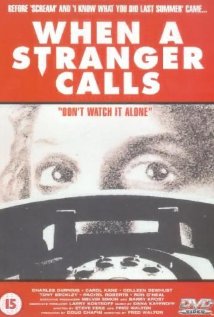The movie “When a stranger calls” starts off with young Jill Johnson, Carol Kane, coming over one evening to the Mandrakis residents to baby-sit for their two small children. As soon as the Mandrakis’ leave Jill starts getting phone calls from some stranger telling her threateningly “Where are the children?”.
At first Jill thinking that it’s her boyfriend playing a joke on her ignores them but as the calls get more frequent and scary Jill feels that this person is not her boyfriend but a dangerous stranger who is somehow watching her from outside the house and calls the police for help. Jill is told by an officer at the police station to keep the caller on the phone the next time that he calls so that they can trace him.
Jill does just that the next time the caller gets on the phone line and keeps him on as long as possible until he himself realizes that that Jill is trying to trap him and quickly hangs up. A moment later Jill gets a call from the police station telling her to immediately leave the house! the person calling her is in there with her and the Mandrakis’ children and is calling from an upstairs phone! Terrified Jill bolts for the door, as the caller suddenly appears from the upstairs bedroom, and as the door swings open she runs right into the arms of police officer John Clifford, Charles Durning, as the house is surrounded by the entire local police department. Later the two Mandraiks’ children were found dead in their beds and the killer Curt Duncan, Tony Beckley, was apprehended by the police.
The first twenty minutes of the movie “When a stranger calls” was one of the most spine-tingling and heart-dropping twenty minutes in any horror or any other type of suspense/mystery movie ever made. The movie never comes close to that level of sheer shock and terror that it reached after that horrific beginning and it was all done by the director, Fred Walton, manipulating his audience with shadows and sounds and with what was happening off-screen and nothing else.
After that “When a Stranger Calls” becomes just a good horror movie with the killer, Duncan, escaping from a mental institution some seven years later and the cop Clifford, who was on the murder case at the start of the film, now a private investigator, tracking him down. On the lamb and on the run Duncan at first seems to have a fixation on Tracy, Colleen Dewhurst, when he sees her in a bar and almost gets himself killed by a bar patron when he just doesn’t want to stop harassing her.
Later finding out where Tracy lives Duncan brazenly invites himself into her apartment only to be thrown out by her when she threatens to call the police. Clifford finding out that Duncan has been bothering Tracy tries to have her trap him only to have Duncan make a run for it, after he tried to beat or even kill Tracy, when she screamed and scared him away. Clifford chases Duncan all over the streets and all through a homeless shelter where Duncan lived until he disappeared in the dark city streets.
The movie ends like it started with Jill now Mrs. Jill Lockart, married and with two young children of her own,being revisited by Duncan as he tries to repeat the same crime that he committed at the beginning of the movie. This time Clifford comes to Jill’s and her children rescue but was to late to save Jill’s husband Steve, Richard Bail,as he puts the killer away by blasting him with a couple of slugs from his handgun.
Terrific low-budget horror movie who’s opening scene has been copied many times since it’s release in 1979. Very good performances by Carol Kane, Charles Durning, Colleen Dewhurst and of course the late Tony Beckley as the killer Curt Duncan. What is so good about “When a Stranger Calls” is that it has almost no gory scenes at all in it but at the same time is far more terrifying that most horror films that have gallons of gore and piles of bodies and body parts in them. Well worth your money and time to rent and watch the VSH tape or DVD of this solid horror classic or to watch it un-cut on cable-TV whenever it’s broadcast.

